In 2025, Ivanti is still one of the big names in IT service management, especially for organizations already deep into the Ivanti ecosystem.
But when you try to understand what it actually costs to run your ITSM on Ivanti, things get fuzzy fast.
Between modular licensing, implementation services, and extra costs for automation or advanced capabilities, it can be hard to know whether you’re getting a smart investment… or signing up for a long, expensive commitment.
In this guide, I’ll unpack:
- What’s known about Ivanti’s pricing model?
- What typically drives costs up?
- Where do teams start to feel the trade-offs in terms of value, complexity, and flexibility?
What’s known about Ivanti’s pricing model?
And then, I’ll compare that experience to an alternative no-code ITSM platform designed to help IT teams get fully operational without enterprise-grade friction to provide you with a reference point for evaluating Ivanti’s value for money.
Let’s dive straight in!
Does Ivanti offer a free plan or trial?
If you're considering Ivanti for your ITSM solution, one of the first questions is whether you can test it out without a full commitment.
Ivanti doesn’t follow the typical modern SaaS approach, where you can create an account, explore a sandbox, or test ITSM workflows on your own.
Simply put, there’s no free plan, and no instantly accessible self-serve trial.
Instead, Ivanti takes a sales-led evaluation path, meaning you must request a demo from its team to see the platform in action.
So, if you prefer to test tools immediately, validate workflows, or compare platforms side-by-side before a sales call, Ivanti’s evaluation process may feel slower and less flexible than more modern, self-serve ITSM platforms.
Ivanti pricing plans
When it comes to Ivanti’s paid tiers for ITSM, there are four plans to choose from:
- ITSM Professional.
- ITSM Enterprise.
- ITSM Premium.
- ITSM Enterprise Premium.

Let’s get a closer look at what each plan includes:
Ivanti ITSM Professional plan
Ivanti doesn’t publish a flat price for any of its ITSM tiers, but the Professional plan is positioned as the entry point for teams that need full-service ITSM plus asset management and discovery.
It’s the foundation of Ivanti’s ITSM offering, and the plan most organizations start evaluating first.

While pricing is only available through a custom quote, here’s what the Professional tier includes based on Ivanti’s official feature set:
- Incident Management: Standard ticketing and issue resolution workflows.
- Request Management: Intake and fulfillment processes for common IT requests.
- Change Management: Structured change controls to reduce risk and maintain stability.
- Service Level Management: Track SLAs and measure whether teams are meeting response and resolution targets.
- Knowledge Management: Create and maintain a central knowledge base for agents and end users.
- Event Management: Surface system events and alerts that may require IT action.
- Configuration Management: Manage CI data across infrastructure, devices, and services.
- Runbook Automation: Build automated actions to streamline repetitive IT tasks.
- Omni-channel Self-Service: Let employees submit requests via portal, mobile, or other supported channels.
- Dashboards & Reporting: Access operational metrics, performance insights, and customizable visualizations.
- ITAM: Track hardware and software inventory across the business.
- Asset Discovery: Automatically identify devices connected to the network.
- Spend Optimization: Manage licenses, reduce software overspend, and identify under-utilized assets.
Ivanti ITSM Enterprise plan
Ivanti’s ITSM Enterprise tier is designed for organizations that want to go beyond traditional IT support and extend service management practices across multiple departments.
Like the Professional plan, pricing is not publicly listed, so you’ll need a custom quote based on users, modules, and implementation scope.
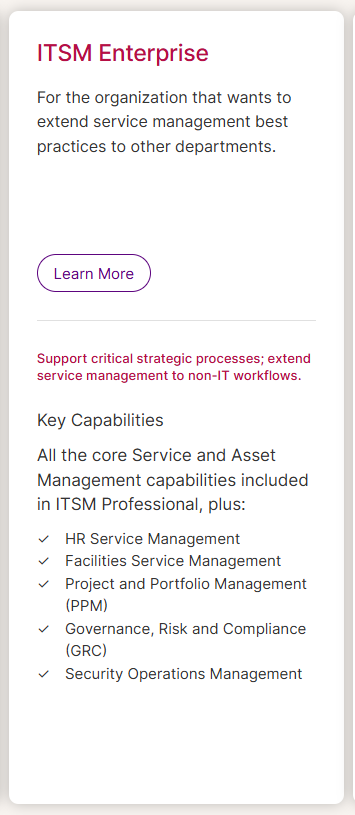
What sets Enterprise apart is its ability to turn Ivanti into a cross-functional service platform, supporting everything from HR and Facilities to security and governance workflows.
Here’s what the Enterprise tier adds on top of everything included in ITSM Professional:
- HR Service Management: Standardize onboarding, offboarding, employee requests, and HR case workflows.
- Facilities Service Management: Manage maintenance requests, building operations, resource allocation, and facility-related incidents from the same platform IT uses.
- Project and Portfolio Management (PPM): Track strategic initiatives, prioritize work, monitor budgets, and connect projects directly to ITSM processes like incidents or changes.
- Governance, Risk and Compliance (GRC): Centralize risk assessments, control activities, compliance documentation, and governance workflows.
- Security Operations Management: Coordinate threat response, manage security incidents, and integrate with security tools to streamline remediation efforts.
Ivanti ITSM Premium plan
The ITSM Premium tier is built for organizations that want to infuse AI, predictive insights, and proactive service management into their IT operations.
As with the other plans, Ivanti does not publish pricing for this tier, and costs depend on custom quotes, implementation scope, and optional add-ons.

What distinguishes Premium from the Enterprise and Professional tiers is its focus on intelligent ITSM, using automation and machine learning to prevent issues before they impact employees.
Here’s what the Premium plan layers on top of all ITSM Professional capabilities:
- AI-Guided ITSM: Surface recommended actions, automate responses, support agents with contextual insights, and leverage machine learning to accelerate ticket resolution.
- Proactive Service Management: Identify issues before they become incidents, automate corrective actions, and reduce repetitive troubleshooting through predictive analytics and automated workflows.
- Digital Experience Focus (DEX): Monitor device health, performance, and user experience metrics to improve service quality, reduce friction, and drive higher employee satisfaction.
Ivanti ITSM Enterprise Premium plan
ITSM Enterprise Premium is Ivanti’s highest and most comprehensive tier, combining everything from core ITIL processes to enterprise-wide service management, automation, AI-driven insights, and digital experience monitoring.
This plan is designed for large organizations that want a single, intelligent platform powering every service workflow across IT and non-IT departments.
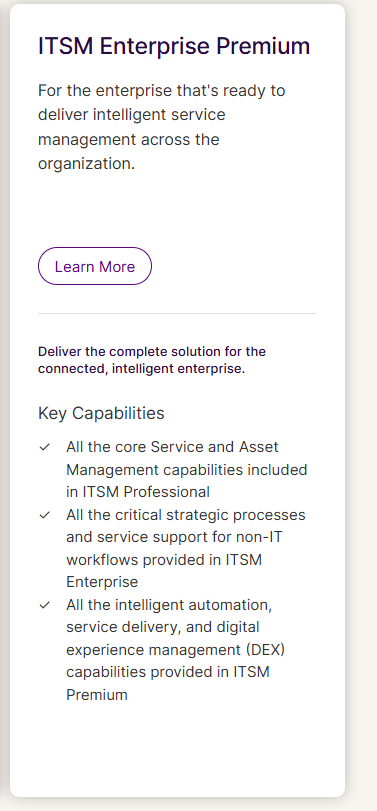
As with all other Ivanti tiers, pricing for Enterprise Premium is not publicly available.
The Enterprise Premium tier includes:
- All core IT service and asset management features from ITSM Professional.
- All cross-department service workflows from ITSM Enterprise.
- All advanced automation, AI-driven service delivery, and DEX capabilities from ITSM Premium.
How much does Ivanti actually cost in 2025?
As we’ve seen, Ivanti doesn’t publish pricing for any of its ITSM tiers.
Instead, Ivanti emphasizes a modular, quote-based model, where costs depend on the specific capabilities you select, the scope of implementation, and other factors its team deems relevant.
In practice, this means you can’t estimate your spend until you’ve gone through a sales conversation, and for many teams, that makes early budgeting difficult.
Still, third-party benchmarks help give us a better sense of the market reality.
According to Vendr’s 2025 data, the median Ivanti contract is $6,395 per year, with purchases ranging from $2,310 to $7,996.

Source: Vendr.
These figures usually represent smaller Ivanti deployments or individual product suites, not full ITSM Enterprise or Premium packages, which can cost significantly more once you factor in non-IT modules, AI/DEX capabilities, or broader automation requirements.
Other software directories (like Capterra and SoftwareAdvice) also list Ivanti as “Contact vendor for pricing”, reinforcing that even basic or mid-market customers won’t get visibility into cost upfront.
In short, while Ivanti offers a robust ITSM platform, its opaque pricing, custom licensing, and variable implementation costs make it challenging to understand the true total cost of ownership without entering a full sales cycle.
Does Ivanti provide good value for money in 2025?
Ivanti earns positive feedback for its flexibility and depth, especially for organizations that need a platform they can tailor heavily to their processes.
Many users highlight that once configured, Ivanti can automate complex workflows, integrate with a wide range of systems, and support large-scale service operations across IT and non-IT teams.
And for companies with the skills and resources to customize it, Ivanti can absolutely deliver solid long-term value.
But that same power comes with trade-offs.
Numerous users struggle with Ivanti’s:
- Steep learning curve: Many note that maximizing ROI takes time and technical expertise.
- Time-consuming customizations: Even though the system is flexible, building and maintaining changes takes effort.
- Backend complexity: Some modules feel disjointed, and workflows and configuration require navigating multiple layers.

- Outdated or cluttered UI in places: This makes navigation more difficult, especially for beginners.

Considering all this, it’s fair to say that Ivanti provides strong value for organizations that want deep customization, run complex environments, and, most importantly, have the necessary resources to design, maintain, and evolve a highly tailored ITSM system.
However, for teams with smaller budgets or limited admin capacity, the combination of complexity, upkeep, and opaque pricing can reduce the perceived ROI, especially when more modern, no-code platforms now offer similar capabilities with far lower overhead.
Looking for an Ivanti alternative?
After reviewing Ivanti’s pricing, modular structure, and real-world user experience, it’s clear that the platform can be extremely powerful, but only if you have the time, budget, and technical resources to unlock that power.
For many IT teams in 2025, that trade-off feels heavier than it used to.
If you’re reconsidering your ITSM investment because of:
- Opaque, sales-led pricing,
- Complex configuration and a steep learning curve,
- Inconsistent UI or fragmented modules,
- Heavy admin effort to maintain customizations,
- Or simply needing a solution you can deploy faster and scale cleaner
- then you’re not alone.
More organizations are looking for ITSM platforms that deliver enterprise-grade functionality without enterprise-level friction.
That’s where SmartSuite stands out.

SmartSuite gives you the service management depth you expect from a leading ITSM platform, but in a modern, no-code environment that’s fast to launch, easy to evolve, and far more transparent in cost.
It’s built for IT teams that want to streamline operations, automate intelligently, and support the entire business without spending months configuring or negotiating licenses.
Let’s break down the key features that make SmartSuite such a strong Ivanti alternative.
1. Unified, all-in-one ITSM without fragmented modules
One of the biggest challenges Ivanti users mention is how disconnected the platform can feel.
Different modules have different interfaces, some areas still rely on legacy architecture, and workflows often span multiple sections of the system.
That flexibility is powerful, but it also introduces complexity, and a lot of administrative overhead.
SmartSuite takes the opposite approach.
Instead of stitching together separate systems, it brings every critical IT process into one modern, consistent workspace so teams can run service operations end-to-end without friction.
With SmartSuite, you get a single place to:
- Handle day-to-day support work, from incoming tickets to ongoing issues, without jumping between different modules or dashboards.

- Keep track of every device, system, and software license - who it belongs to, when it renews, and whether it’s up to date.
- Route work requests and approvals automatically, ensuring technicians stay focused on priority tasks and service levels don’t slip.

- Run internal IT initiatives by planning deployments, assigning work, and following progress in real time.
- Centralize your IT policies and documentation, and connect them to the audits or checks that keep your organization secure and compliant.

- See the full picture instantly, thanks to live dashboards that highlight trends, risks, and bottlenecks across your IT operations.
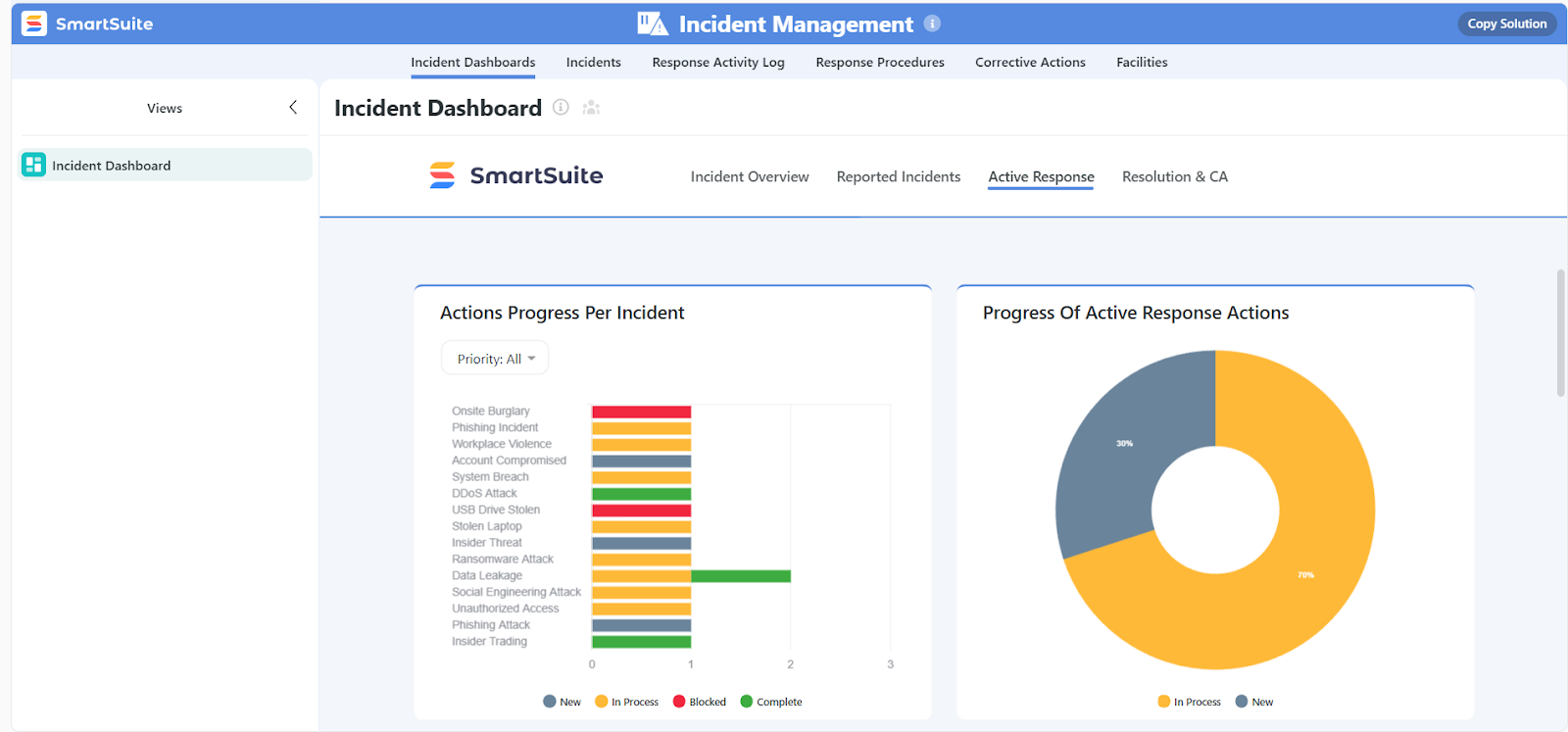
The result is an ITSM platform that feels cohesive, predictable, and easy to navigate - everything Ivanti strives for, delivered with far less complexity.
2. True no-code customization (without the admin burden)
Ivanti consistently earns praise for being highly customizable, but reviewers are just as quick to point out the trade-offs: configuration takes time, the backend can feel scattered, and even simple changes sometimes require digging through multiple layers of the system.
For teams without dedicated technical admins, that quickly becomes a bottleneck.
With SmartSuite, everything is built to be adapted by the people who actually run IT operations - not developers, not outside consultants, and not full-time system architects.
Here’s what you can effortlessly do with SmartSuite:
- Adjust fields, forms, and layouts through simple drag-and-drop controls instead of navigating hidden backend menus.

- Create automated workflows for ticket routing, approvals, escalations, and reminders, with no scripting or complex rule-building required.
- Build custom views and dashboards that reflect exactly how your team works, from technician workloads to asset health to SLA performance.

- Tailor templates for help desk, assets, licenses, and security without touching code or relying on multi-week configuration cycles.
The result is a platform where customization feels natural and lightweight, instead of being more of a technical project.
You still get the flexibility Ivanti is known for, but without the administrative overhead, steep learning curve, or reliance on backend specialists.
3. ITSM templates that get you operational fast
One of the biggest barriers to adopting an ITSM platform is the setup.
SmartSuite turns the setup process on its head with ready-made ITSM templates designed around real workflows modern IT teams run every day.
Instead of starting from a blank canvas or a half-configured module, you start with structured, industry-aligned solutions you can use immediately.
SmartSuite’s ITSM library includes templates such as:

- IT Service Request Management: A structured workflow for capturing and resolving employee technology issues.
- IT Help Desk: Preconfigured queues, assignments, categories, and communication tools for handling support tickets.
- IT Asset Tracker: Track hardware, devices, lifecycle stages, maintenance schedules, and ownership across your organization.
- IT Security Audits: Organize security checks, controls, findings, and follow-up actions to support compliance and risk mitigation.
- Software Licenses: Maintain license records, renewal dates, entitlements, and documentation in one place.

- Incident Management: Log, prioritize, assign, and resolve incidents with built-in escalation paths and severity tracking.
- Visitor Tracker: Modernize visitor intake with digital sign-in and automatic notifications.
And because each template is built on SmartSuite’s no-code foundation, teams can adjust fields, automations, approvals, or dashboards with just a few clicks.
4. Cross-department service management (without the complexity Ivanti requires)
One of Ivanti’s biggest strengths is that it can extend service management beyond IT - to HR, Facilities, Security, Finance, and other teams.
The tradeoff?
Each expansion typically requires additional modules, extra configuration, and deeper administrative expertise.
It’s powerful, but not always practical for lean IT teams or fast-moving departments.
SmartSuite takes a far more accessible approach.
Because it’s built as a unified work management platform - and not a collection of separate ITSM products - cross-department support is built in from the start.
Any team can adopt structured service workflows without needing new modules, licenses, or backend rebuilds.
With SmartSuite, non-IT teams within your organization can also launch service operations in minutes, not months:
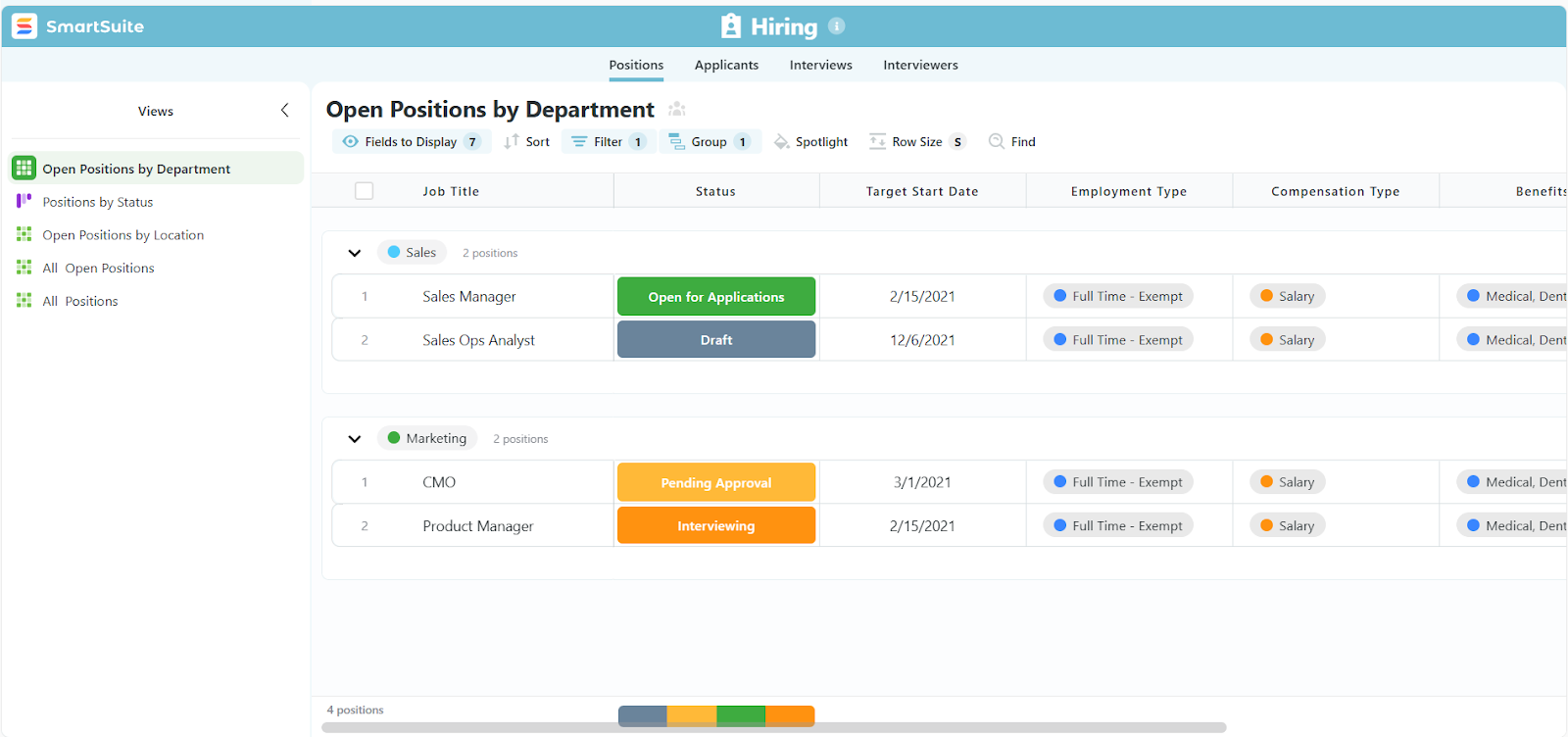
- HR: Onboard/offboard employees, track requests, manage policies, run internal service queues.
- Facilities: Handle maintenance work orders, room/asset requests, inspections, and repairs.

- Legal & Finance: Manage approvals, contract reviews, purchasing workflows, and process documentation.

- GRC: Ensure compliance with relevant regulation across your organization from a single, highly intuitive point of control.
Every department gets the same advantages, such as automations, dashboards, approval workflows, templates, forms, notifications, etc., without needing a separate tool or a dedicated admin.
For teams that want the cross-department reach of Ivanti minus the overhead and multi-product sprawl, SmartSuite offers a far more straightforward path.
5. Real-time collaboration built directly into your ITSM workflows
SmartSuite removes any communication friction by baking real-time collaboration into every part of the ITSM experience.
With SmartSuite, teamwork happens where the work lives:
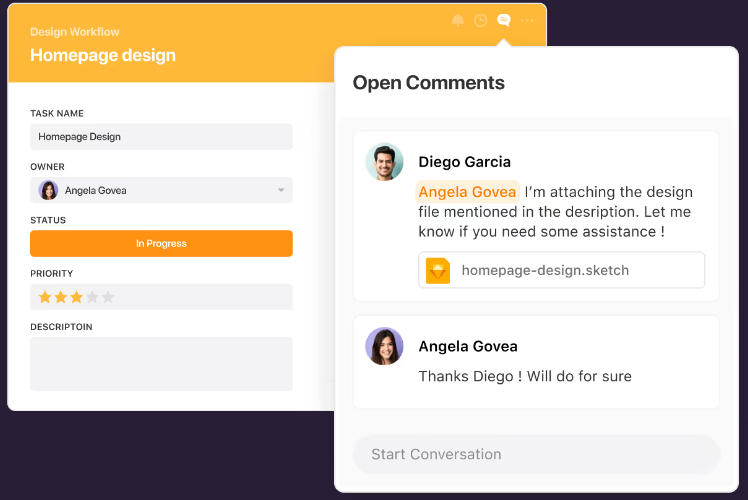
- In-record conversations let technicians comment, tag teammates, attach screenshots, and share context directly inside tickets, assets, incidents, or requests.
- Live, multiplayer editing ensures multiple team members can update the same record at the same time, with changes visible instantly.
- Integrated email communication keeps inbound and outbound messages tied to the exact ticket they belong to, so there’s no inbox digging or copy/paste required.
- @Mentions and notifications make it easy to pull in the right person fast, reducing bottlenecks and handoff delays.

- Mobile collaboration via SmartSuite’s iOS and Android apps allows technicians to respond, upload photos, or resolve issues while on site or on the go.
- Complete activity histories track every action, including status changes, field edits, assignments, and more, so managers have instant visibility and technicians never lose context.

The result? Faster resolutions, fewer miscommunications, and a more connected IT team that operates smoothly across locations, time zones, and devices.
How does SmartSuite’s pricing compare to Ivanti’s?
If there’s one thing that consistently frustrates IT teams evaluating Ivanti, it’s the lack of pricing transparency. Ivanti doesn’t publish public pricing for any of its ITSM tiers, and costs vary dramatically depending on various factors.
SmartSuite takes the opposite approach.
You get simple, transparent, per-user pricing that any IT team can understand immediately - no hidden modules, no forced add-ons, and no surprises after onboarding.
Firstly, it offers a Free Forever plan, which is perfect for small teams or IT departments testing the waters. It includes up to 3 users, 5 solutions, dashboards, real-time collaboration, automations, and core ITSM templates.
And if you need more features, SmartSuite has four paid tiers that scale predictably with your team:
- Team: $12/user/month, includes everything in Free, plus unlimited solutions, 5,000 records per solution, 50GB of file storage, advanced collaboration tools, and a 30-day recycle bin.
- Professional: $30/user/month, includes everything in Team and adds advanced permissions, two-factor authentication, Gmail & Outlook integrations, AI features, and 100GB of file storage.
- Enterprise: $45/user/month, includes everything in Professional, plus audit logs, data loss prevention, up to 50,000 monthly API calls, and 500GB of file storage.
- Signature: Custom pricing, a fully tailored plan with no predefined limits, offering extended storage, API capacity, records, automations, and advanced enterprise security options such as SCIM provisioning and regional data residency.

All paid plans also include a 14-day free trial (no credit card required), so teams can validate fit before making a commitment - something Ivanti doesn’t offer.
How is SmartSuite different from Ivanti?
Ivanti delivers deep, enterprise-grade ITSM, but it often comes with a high degree of complexity, opaque pricing, and time-intensive administration.
SmartSuite takes a fundamentally simpler, more modern approach built for speed, clarity, and ease of use.
Here’s how they differ at a glance:
- Platform structure: Ivanti’s power is spread across multiple modules and interfaces, which can feel fragmented. SmartSuite brings tickets, incidents, assets, requests, audits, policies, and projects into one consistent workspace, reducing the friction of switching between modules.
- Customization complexity: Ivanti is flexible but requires navigating a technical backend and layered configurations. SmartSuite lets teams customize fields, forms, workflows, and dashboards with drag-and-drop controls, so changes take minutes, not weeks.
- Configuration effort: Ivanti often demands extensive configuration before teams can go live. SmartSuite provides a wide range of ready-made templates, so teams can start running ITSM on day one.
- Cross-department expansion: Ivanti can support HR, Facilities, Security, and other teams, but usually through added modules and configuration. SmartSuite extends service management across the business out of the box, using the same templates and automation engine across all departments.
- Pricing policy: Ivanti publishes no pricing, making budgeting unpredictable. SmartSuite offers clear per-user pricing, a Free Forever plan, and a 14-day trial.
Choosing the right ITSM path in 2025
Ivanti remains a capable, enterprise-grade ITSM platform, but its modular pricing, complex configuration, and steep learning curve make it a heavier investment than many teams expect.
For organizations with large budgets, dedicated admins, and the need for deep customization, Ivanti can deliver strong results.
For everyone else, the trade-offs in flexibility, speed, and clarity are hard to ignore.
SmartSuite offers a different path.
A modern, unified ITSM workspace where teams can launch quickly, customize without code, collaborate in real time, and manage tickets, assets, requests, audits, and cross-department workflows, all without the hidden modules or opaque licensing.
If your priority is getting fully operational fast, staying agile as needs evolve, and knowing exactly what you’re paying for, SmartSuite is built for you
Start your free 14-day trial today - no credit card required.
Read more
- 10 Best Ivanti Alternatives For ITSM In 2025 [Reviewed] - Discover the strongest Ivanti challengers of 2025 that deliver faster workflows, modern interfaces, and easier ITSM automation without the enterprise bloat.
- ServiceNow vs. Ivanti vs. SmartSuite: Which One Is Better? - A head-to-head breakdown of three major ITSM platforms, revealing which one actually delivers the best value, usability, and scalability in 2025.
- Onspring Pricing: Is It Worth It In 2025? - Get a clear, honest look at Onspring’s real costs, limitations, and value so you know exactly what you’re paying for before booking a demo.
- 10 Best Freshservice Alternatives for ITSM in 2025 - Explore the top Freshservice competitors that offer cleaner UI, stronger automation, and more flexible ITSM experiences at every budget.
- SysAid Pricing: Is It Worth It In 2025? - A breakdown of SysAid’s pricing, features, and trade-offs to help you understand whether the platform still delivers solid ITSM value in 2025.
- 10 Best SolarWinds Alternatives & Competitors In 2025 - See the most reliable, modern SolarWinds replacements that bring stronger security, better monitoring, and far less operational risk.

Run your entire business on a single platform and stop paying for dozens of apps
- Manage Your Workflows on a Single Platform
- Empower Team Collaboration
- Trusted by 5,000+ Businesses Worldwide















